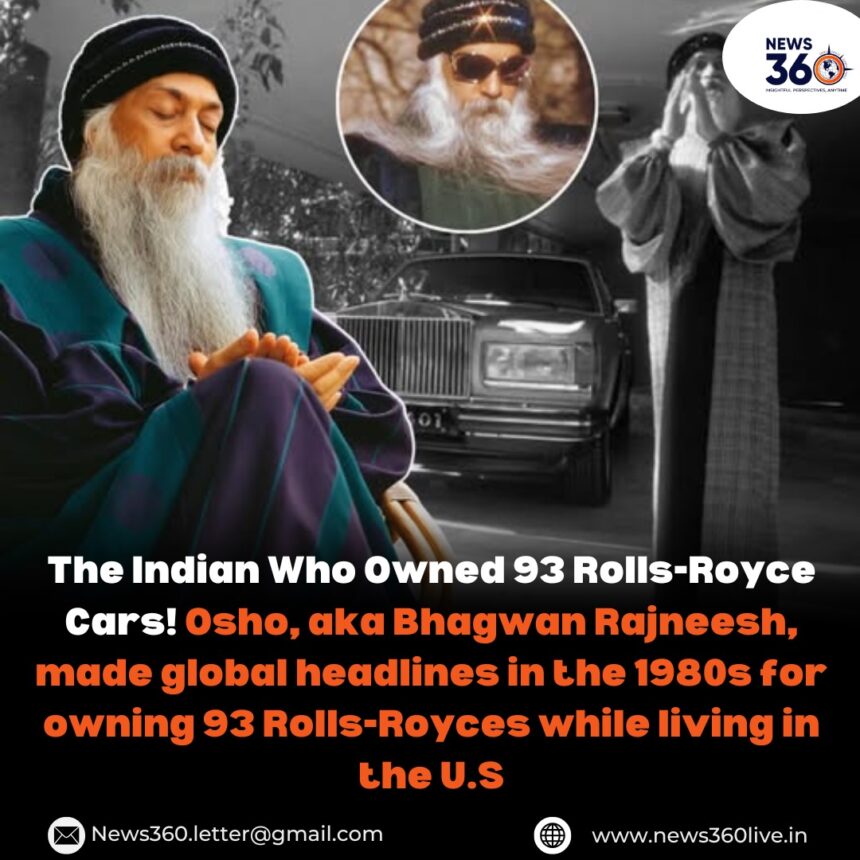Discover How Osho, Also Known as Bhagwan Rajneesh, Shocked the World with His Collection of 93 Rolls-Royces in the U.S.: A Blend of Mysticism, Controversy, and Opulence That Intrigues Millions Today
Introduction
Osho, the spiritual leader often called Bhagwan Rajneesh, remains one of the most debated figures in modern history. His teachings of love, freedom, and meditation drew many followers, but his life was also filled with controversy. What really caught people’s attention was his astonishing collection of 93 Rolls-Royces in the United States. This display of wealth puzzled and fascinated millions worldwide. This article uncovers the story behind Osho’s luxurious lifestyle, explores the controversy it caused, and shows why his story still sparks debate today.
The Life and Legacy of Osho: From Spiritual Teacher to Cultural Icon
Early Life and Spiritual Awakening
Born as Bhagwan Shree Rajneesh in India, Osho started life in a modest family. As he grew older, he became deeply interested in spiritual questions. His quest for truth led him to teach meditation and self-awareness. During the 1960s and 1970s, his ideas about personal freedom and spirituality gained popularity across India.
Transition to the U.S. and Global Influence
In the 1980s, Osho moved to the United States. He established a large commune in Oregon, attracting followers from all over the world. The commune became known for its unique blend of meditation, therapy, and free love. Osho’s message of breaking free from traditional religion appealed to many Westerners seeking spiritual answers outside the church. His influence grew, making him a global icon of modern spirituality.
Osho’s Controversies and Cultural Impact
Osho’s teachings emphasized sexual liberation and personal freedom, which upset many critics. Law enforcement also looked into his group, and in 1985, he was arrested and charged with various offenses. Despite legal battles, many followers continued to see him as a revolutionary spiritual figure. Today, his ideas still inspire some, while others view him as a symbol of excess and contradiction.
The Astonishing Collection of Rolls-Royces: Facts and Context
The Rise of Opulence: How Did Osho Collect 93 Rolls-Royces?
How did a spiritual leader amass such a huge car collection? Osho’s collection grew over the years, starting with a few luxury cars and eventually reaching 93 Rolls-Royces. He bought these cars as symbols of success and luxury. Some reports say he acquired around 20 cars in just a few years, and the number kept climbing. Why choose Rolls-Royce? This brand’s reputation for elegance and exclusivity made it the perfect way to showcase wealth.
The Symbolism of Wealth in Osho’s Philosophy
People often debated if material possessions fit with spiritual teachings. Osho believed in abundance and freedom, and his cars symbolized his belief that life was meant to be enjoyed fully. Some followers saw his fleet as a way to show that wealth could be a tool for expression, not just greed. Critics, however, argued it was a contradiction to his message of simplicity and spiritual focus.
Notable Rolls-Royce Models in the Collection
Many of the cars in Osho’s collection were classic models, each with custom features. Some were painted in bright colors, while others had special interiors. The most famous was a silver Rolls-Royce Corniche, seen as a symbol of his flamboyant style. Some cars even had personalized license plates, emphasizing his desire for attention and status.
Public Reaction and Media Portrayal
Media Coverage of Osho’s Luxury Lifestyle
Once news broke about his Rolls-Royce collection, media outlets couldn’t resist. Tabloids focused on the contrast between his spiritual teachings and his lavish cars. Mainstream news often painted him as a symbol of excess and hypocrisy. The story became a talking point on whether a spiritual leader should show off wealth.
Supporters and Critics’ Perspectives
Supporters argued that Osho used wealth to challenge traditional views. They believed his cars were a sign of his success and freedom to live on his terms. Critics called him a hypocrite, accusing him of hypocrisy. They said his luxury contradicted his message of simplicity and spiritual purity.
Analysis of the Cultural and Ethical Implications
Why does a spiritual leader need a fleet of luxury cars? That question sparked endless debates about the nature of true spirituality. Does wealth spoil purity, or can it be a tool to inspire others? Osho’s story makes us think about the balance between material success and spiritual integrity.
Controversies, Legal Challenges, and the Fall
The Oregon Commune Dispute and Legal Issues
In 1984, Osho’s Oregon commune faced serious legal issues. Authorities accused his followers of various crimes, and a crackdown began. The situation escalated quickly, leading to arrests and protests. The Rolls-Royces, once symbols of his success, were heavily scrutinized during this time. They became part of the controversy surrounding his legal battles.
Impact on Osho’s Public Image and Movement
Legal troubles hurt Osho’s reputation. Many followers felt betrayed, while critics used the controversy to criticize him. His physical presence in America faded, but his teachings and style kept spreading. Despite all this, some argue his influence grew even stronger after his legal issues, as he became more of a legend.
Legacy of the Controversy in Today’s Spiritual Circles
Today, Osho’s story remains a case study in the risks of mixing spirituality and materialism. Many modern spiritual figures try to avoid his pitfalls by promoting a more balanced approach. Still, many admire his boldness and question why we often judge spiritual leaders by their possessions.
Enduring Fascination and Lessons from Osho’s Opulence
Why Osho’s Rolls-Royces Continue to Intrigue
His collection symbolizes more than just luxury. It shows how a spiritual figure can challenge norms and stir controversy. The idea of a monk with a fleet of shiny cars pushes us to rethink what it means to be spiritual. Osho’s story is a reminder that wealth and spirituality are complex and often intertwined.
Actionable Insights
What can spiritual leaders or entrepreneurs learn from Osho’s life? Success isn’t wrong, but authenticity matters. Balancing material comfort with genuine soul-searching is key. Followers should look beyond images and examine the true depth of a leader’s message.
Modern Comparisons and Cultural Relevance
Today, many celebrities and spiritual icons blend luxury and mysticism. Some buy expensive jewelry, private jets, or luxury homes. The challenge is how to enjoy wealth responsibly without losing sight of core values. Osho’s story warns us to stay true to what matters most.
Conclusion
Osho’s life is a mix of mysticism, controversy, and opulence that still sparks discussion. His collection of 93 Rolls-Royces remains a symbol of material excess in the world of spirituality. His story teaches us that success can be both inspiring and risky, depending on how it’s used. As we reflect on his legacy, we see that the line between wealth and spirituality is often blurred but worth examining. His life remains a fascinating example of how people interpret and challenge the meaning of true enlightenment.

